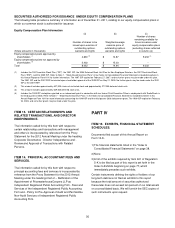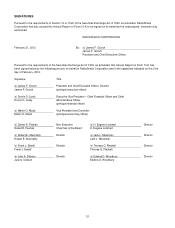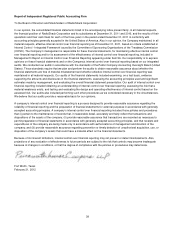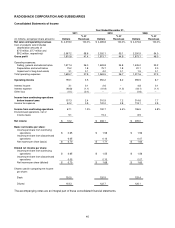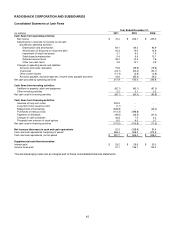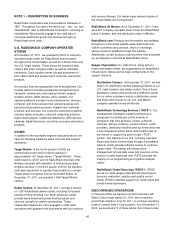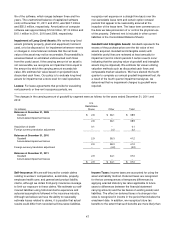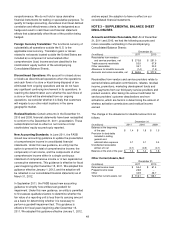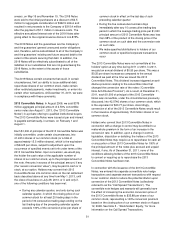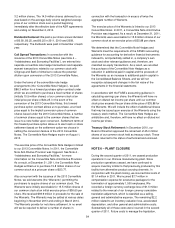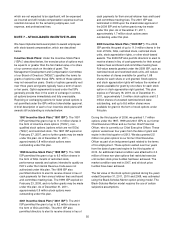Radio Shack 2011 Annual Report Download - page 54
Download and view the complete annual report
Please find page 54 of the 2011 Radio Shack annual report below. You can navigate through the pages in the report by either clicking on the pages listed below, or by using the keyword search tool below to find specific information within the annual report.46
were transitioned to Sam’s Club by June 30, 2011. We
determined that the cash flows from these kiosks have
been eliminated from our ongoing operations. Therefore,
these operations were classified as discontinued operations
and the operating results of these kiosks are presented in
the consolidated statements of income as discontinued
operations, net of income taxes, for all periods presented.
We incurred no significant gain or loss associated with the
transition of these kiosks to Sam’s Club. We redeployed
substantially all of our Sam’s Club kiosk employees to
nearby RadioShack stores or Target Mobile centers, and
we redistributed our Sam’s Club kiosk inventory to our
remaining retail channels. Net sales and operating
revenues related to these discontinued operations were
$62.9 million, $206.9 million and $202.4 million for 2011,
2010 and 2009, respectively. Income before income taxes
for these discontinued operations was $8.4 million, $25.2
million and $13.9 million for 2011, 2010 and 2009,
respectively.
NOTE 2 – SUMMARY OF SIGNIFICANT
ACCOUNTING POLICIES
Basis of Presentation: The consolidated financial
statements include the accounts of RadioShack
Corporation and all majority-owned domestic and foreign
subsidiaries. All intercompany accounts and transactions
are eliminated in consolidation.
Use of Estimates: The preparation of financial statements
in accordance with accounting principles generally
accepted in the United States requires us to make
estimates and assumptions that affect the reported
amounts of assets and liabilities, related revenues and
expenses, and the disclosure of gain and loss contingencies
at the date of the financial statements and during the periods
presented. We base these estimates on historical results and
various other assumptions believed to be reasonable, all of
which form the basis for making estimates concerning the
carrying values of assets and liabilities that are not readily
available from other sources. Actual results could differ
materially from those estimates.
Cash and Cash Equivalents: Cash on hand in stores,
deposits in banks and all highly liquid investments with a
maturity of three months or less at the time of purchase are
considered cash and cash equivalents. We carry our cash
equivalents at cost, which approximates fair value because
of the short maturity of the instruments. The weighted
average annualized interest rates were 0.3% and 0.4% at
December 31, 2011 and 2010, respectively, for cash
equivalents totaling $426.2 million and $462.1 million,
respectively. We maintain zero balance cash disbursement
accounts with certain banks. Outstanding checks in excess
of deposits with these banks totaled $81.9 million and $49.1
million at December 31, 2011 and 2010, respectively, and
are classified as accounts payable in the Consolidated
Balance Sheets. Changes in these overdraft amounts are
reported in the Consolidated Statements of Cash Flows as
a financing activity.
Accounts Receivable and Allowance for Doubtful
Accounts: Concentrations of credit risk with respect to
customer and dealer receivables are limited due to the
large number of customers, dealers and their location in
many different geographic areas of the country. We
establish an allowance for doubtful accounts based on
factors surrounding the credit risk of specific customers,
historical trends and other information. Historically, such
losses, in the aggregate, have not exceeded our estimates.
Account balances are charged against the allowance when
we believe it is probable that the receivable will not be
recovered. We have concentration of credit risk from
service providers in the wireless telephone industry,
primarily Sprint, AT&T, and Verizon Wireless (“Verizon”).
The average payment term for these receivable balances is
approximately 45 days.
Inventories: Our inventories are stated at the lower of cost
(principally based on average cost, which approximates
FIFO) or market value and are comprised primarily of
finished goods. Included in the cost of the inventories are
in-bound freight expenses to our distribution centers, out-
bound freight expenses to our retail outlets, and other direct
costs relating to merchandise acquisition and distribution.
Also included in the cost of inventory are certain vendor
allowances that are not a reimbursement of specific,
incremental and identifiable costs to promote a vendor’s
products. If the calculated net realizable value of the
inventory is determined to be less than the recorded cost, a
provision is made to reduce the carrying amount of the
inventory to its net realizable value.
Property, Plant and Equipment: We present our property,
plant and equipment at cost, less accumulated depreciation
and amortization. Depreciation and amortization are
calculated using the straight-line method over the following
useful lives: 10-40 years for buildings; 2-15 years for
furniture, fixtures, equipment and software; leasehold
improvements are amortized over the shorter of the terms
of the underlying leases, including certain renewal periods,
or the estimated useful lives of the improvements. Major
additions and betterments that substantially extend the
useful life of an asset are capitalized and depreciated.
Expenditures for normal maintenance and repairs are
charged directly to expense as incurred.
Capitalized Software Costs: We capitalize qualifying
costs related to the acquisition or development of internal-
use software. Capitalization of costs begins after the
conceptual formulation stage has been completed.
Capitalized costs are amortized over the estimated useful


